
|
Static Tests
Performed on the electronic test stands January through December 2006 |

|
Static Tests
Performed on the electronic test stands January through December 2006 |
| < Go to 2005 Tests |
Go to 2007 Tests > |
| Excel File |
Thrust Curve |
Description |
Video |
||||||||||||||||||||||||
| 1-1-06A |
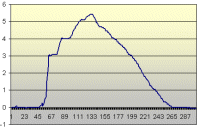
|
18mm paper case motor, 4 inch
length, burning 2.75 inch moonburner grain. Primed by inserting a
strand of black match in the grain core, extending its full length and
overlapping the ends by 1/4 inch or so. Grain is inhibited with
one wrap of Nashua 322 Al-foil tape. Ignited with new ignitor,
Christmas-tree bulb which has it's tip ground off in a belt sander,
filled with finely-ground meal powder, and sealed with a tad of fuse
paper. Held in motor nozzle with masking tape and fired with
Estes 4-AA launch controller. Propellant weight: 13.2ag Total thrust: 12.3Ns, Burn time: 0.8 seconds, ISP: 95 (a bit optimistic, as the the delay grain would have contributed a little, inflating the score. More conservative: Propellant weight is 14.9g, ISP is 84.) |
Video 1 meg, 7 seconds .wmv file |
||||||||||||||||||||||||
| 1-1-06B Analysis (Excel file) |
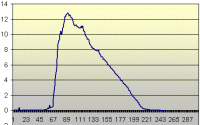 |
18mm paper case motor, 6 inch length, burning 4.2 inch
moonburner grain. Primed by inserting a strand of black match in the
grain core. Ignited with new ignitor, Christmas-tree bulb which has
it's tip ground off in a belt sander, filled with finely-ground meal
powder, and sealed with a tad of fuse paper. Held in motor nozzle with
masking tape and fired with Estes 4-AA launch controller. Propellant weight: 19.8g (not including delay grain) Total thrust: 18.75Ns, Burn time: 0.58 seconds, ISP: 96 - probably not... some of the delay grain burned as propellant, inflating the score. If one web thickness of propellant (1.7g) is assumed to have burned during the propellant phase, then the total propellant producing thrust would have been 21.5g and the ISP 89. |
Video 1 meg, 9 seconds, .wmv file |
||||||||||||||||||||||||
| 1-8-06B Analysis (Excel file) spreadsheet |
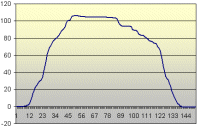 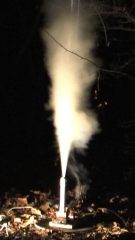 |
38-360 Dr. Rocket motor casing firing single uninhibited grain of KN/SB/SU propellant
made on 12/25/05. Made in the electric skillet, proprotions are
66/17.5/17.5. A small amount of corn syrup was added to improve
its working texture. In an effort to facilitate quick ignition, the bare grain is wrapped in fuse paper made from coffee-filter paper, and a strand of this paper is run along the section of ignitor wire inside the core. It seemed to work, as ignition lag was about .5 second, and the motor rose to pressure much more quickly than on the previous attempt. Propellant weight: 130.1g Total thrust: 148Ns Burn time: 0.38 seconds, Delivered ISP: 116 Thus KN/SB/SU appears to be a viable propellant. Whether it offers significant advantages over KN/SB or KN/SU is yet to be determined. |
Video 850k .wmv file 4 seconds |
||||||||||||||||||||||||
| 1-14-06A Analysis (Excel file) |
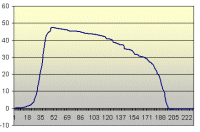 |
38-240 casing,
uninhibited grain using KNO3, sorbitol, sucrose, and dextrose in the
percentages: KN= 66 SB=22 SU= 8.8 DX=2.7 The propellant was made in the electric skillet, and cooked quite a lot at 250 degrees over the course of several days. It is rather hygroscopic, and a bit soft even the next day, but produced a good grain. Propellant weight: 103.1g Total thrust: 113Ns Burn time: 0.70 seconds, Delivered ISP: 112 Good burn, nice curve. slower than would be expected for KN/SU, but Kn ratios were a bit low (188max, 155final) which could have reduced both burn rate and ISP. |
Video 750k .wmv file 4 seconds |
||||||||||||||||||||||||
1-15-06B Analysis (Excel file) |
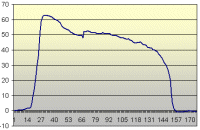 |
38-240 casing,
uninhibited grain using skillet rcandy
made by a quicker method than usual. Once the evaporating mixture
reached the "crystal mush" stage, it was stirred every 2 to 3 minutes
until a cooled sample became firm. This only took about 10
minutes, whole process to make 300 gram batch took 35 minutes. Propellant weight: 107.7g Total thrust: 117Ns Burn time: 0.56 seconds, Delivered ISP: 116 Except for the propellant, this test is very similar to 1-14-06A, and was done primarily to compare the two propellants. They are different. |
Video 900k .wmv file 4 seconds |
||||||||||||||||||||||||
| 1-16-06A Analysis (Excel file) |
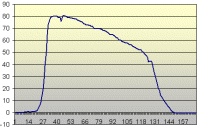 |
38-240 casing,
uninhibited grain using the same skillet rcandy as
the previous test 1-15-05B. Motor and test are the same except
steel washer with .331 inch hole is used as nozzle throat. This
in an effort to develop a standard test motor, with a stable and
reporducible nozzle throat size which will be necessary for comparing
propellant variations. Also ignitor is bridge wire with fuse
paper, no BP. Propellant weight: 109.4g Total thrust: 129Ns Burn time: 0.48 seconds, Delivered ISP: 120 Very quick igniton, good burn. Higher ISP could be attributed to higher Kn ratios. |
Video 824k .wmv file 4 seconds |
||||||||||||||||||||||||
| 1-21-06B Analysis (Excel file) |
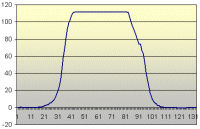 |
38-240 casing,
uninhibited grain composed of skillet rcandy
made with KNO3 from SVRC (pvconly.com) This KNO3 is a little different
from the food grade stuff I've been using, and tends to make a dry
propellant. Water added at intervals to keep it's creamy texture.
Mistake - smaller nozzle throat used than intended, generating higher
pressure, higher thrust, and truncated thrust curve. Ignitor is
bridge wire with fuse
paper, no BP. Propellant weight: 104g Total thrust: 122Ns Burn time: 0.30 seconds, Delivered ISP: 119 Very quick igniton. Fast burn attributed to higher Kn ratios. |
Video 839k .wmv file 4 seconds |
||||||||||||||||||||||||
| 1-21-06C Analysis (Excel file) |
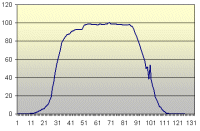 |
38-240 casing, Same propellant load as 1-21-06B except gain on load cell amp set lower in order to capture full data. Propellant weight: 104.9g Total thrust: 122Ns Burn time: 0.35 seconds, Delivered ISP: 119 Very quick igniton. Fast burn and higher ISP could be attributed to higher Kn ratios. |
Video 832k .wmv file 4 seconds |
||||||||||||||||||||||||
| 1-22-06C Analysis (Excel file) |
 |
38-240 casing,
Uninhibited grain made from oven-rcandy using KNO3 from SVRC
(pvconly.com) burning at 5.4 seconds per inch at 1 atm. Similar
to tests on 1/21 except for oven-made propellant and the nozzle throat,
this time 0.327 inch diameter. Propellant weight: 109.8g Total thrust: 133Ns Burn time: 0.48 seconds, Delivered ISP: 124 Quick ignition - In this and the last few tests, the grain is wrapped in fuse paper, with a little overlap at either end. Ignitor is bridge wire wrapped with fuse paper to diameter of about 1/4 inch, and 2 strips of fuse paper packed into grain core behind the ignitor, sealing it in. This flammable plug is thought to divert ignition gasses toward the head end and around the outside of the grain, where fuse paper helps spread the flame. |
Video 839k .wmv file 4 seconds |
||||||||||||||||||||||||
| 1-29-06A Analysis (Excel file) |
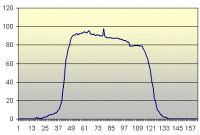 |
38-240 casing,
Uninhibited grain made from skillet-rcandy using KNO3 from SVRC
(pvconly.com) burning at 5.4 seconds per inch at 1 atm. First test of new steel nozzle made by Jon Carter. Propellant weight: 100.2g Total thrust: 128Ns Kn ratios: Initial, 273 Final, 219 Burn time: 0.38 seconds, Delivered ISP: 130 New nozzle performed well, may have contributed to better-than-average ISP. It is discolored a bit, but still smooth. |
Video 902k .wmv file 4 seconds |
||||||||||||||||||||||||
| 1-29-06C Analysis (Excel file) |
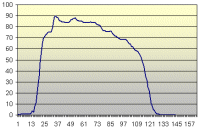 |
38-240 casing,
Uninhibited grain made from open-pan rcandy using KNO3 from Skylighter
burning 9 seconds per inch at 1 atm. Second test of new steel
nozzle made by Jon Carter. Propellant weight: 106.6g Kn ratios: Initial, 273 Final, 219 Total thrust: 138Ns Burn time: 0.44 seconds, Delivered ISP: 132 New nozzle performed well. Again, ISP is better than I usually see in these motors. |
Video 847k .wmv file 4 seconds |
||||||||||||||||||||||||
| 1-29-06D Analysis (Excel file) |
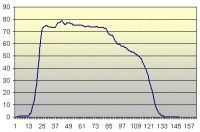 |
38-240 casing,
Uninhibited grain made from open-pan rcandy using KNO3 from Skylighter
burning 9 seconds per inch at 1 atm. Third test of new steel nozzle
made by Jon Carter. Grain adjusted to exactly 100g to provide close test to 1-29-06A, but
this grain is shorter, indicating that the propellant made with SVRC
KNO3 is a bit less dense. Propellant weight: 100.0g Kn ratios: Initial, 256 Final, 203 Total thrust: 126Ns Burn time: 0.46 seconds, Delivered ISP: 128 New nozzle performed well. ISP is a tad lower, perhaps because smaller grain offers lower Kn ratios. |
Video 903k .wmv file 4 seconds |
||||||||||||||||||||||||
| 1-29-06E Analysis (Excel file) |
 |
38-240 casing,
Uninhibited grain made from open-pan rcandy using KNO3 from Skylighter
burning 9 seconds per inch at 1 atm. Added 0.9g Fe2O3 to this propellant. Propellant weight: 103.9g Kn ratios: Initial, 263 Final, 209 Total thrust: 137Ns Burn time: 0.33 seconds, Delivered ISP: 135 Fourth test of new steel nozzle made by Jon Carter. After a rinse and a wipe, it still looks good. No measurable erosion. Faster burn is attributed to Fe2O3, probably higher ISP too because of higher pressure. |
Video 903k .wmv file 4 seconds |
||||||||||||||||||||||||
| 2-26-06A 1 through 4 |
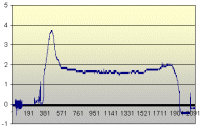
|
Endburners - 3/4ths inch ID paper tubes used
to make end-burning motors, in an effort to determine whether rcandy might
serve as a propellant in Jetex-type motors. Thrust was higher than expected, so these motors might see use as long-burning sustainers. See the Endburner page for details and videos. |
|||||||||||||||||||||||||
| 3-5-06A (click for Excel spreadsheet analyzing this test) |
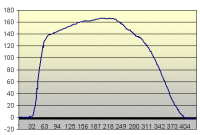
|
54mm Loki 1600 casing,
burning 4 BATES grains skillet rcandy. This is my first test of this
motor. Nozzle is old-style, throat drilled to 0.5 inch diameter. New
nozzle has inset shoulder for support ring, allowing 0.3 inch more propellant
column and requiring slightly longer case liner. Propellant weight: 723g Kn ratios: Initial, 212 Max, 246 Final, 220 Total thrust: 829Ns Burn time: 1.44 seconds, Delivered ISP: 116 Ignition was with fuse paper alone in ignitor. Fuse paper also placed between grains and wadded in core to speed ignition. Ignition lag of 1.3 seconds is acceptable, but could be better. Case is undamaged and cleaned up well. Successful test! |
Video 941k .wmv file 6 seconds |
||||||||||||||||||||||||
| 3-25-06 Excel spreadsheet analyzing this test |
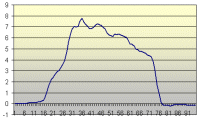 |
18mm motor using Pixy Stix rcandy.
Substituted the contents of a dozen Pixy Stix for an equivalent
amount of sugar, prepared by the electric skillet method.
Propellant catalyzed with 1% Fe2O3. Propellant weight: 7.4g Kn ratios: Initial and max, 130 Final, 108 in theory, actually more likely 60 due to nozzle erosion Total thrust: 5.84Ns Burn time: 0.27 second, Delivered ISP: 81 Test demonstrates that this kind of candy can be used to make a viable propellant. It does not seem much different from propellant made with pure sucrose. |
Video 1 meg .wmv file 8 seconds duration |
||||||||||||||||||||||||
| 4-1-06B Analysis (Excel file) |
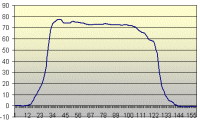 |
38-240 motor using Pixy Stix rcandy.
Substituted contents of two 4-ounce packages Pixy Stix for an equivalent
amount of sugar, prepared by the electric skillet method.
Burn rate at 1atm is 18 seconds per linear inch Propellant weight: 106.3g Kn ratios: Initial and max, 284 Final, 228 Total thrust: 133Ns Burn time: 0.48 second, Delivered ISP: 128 Comparison of this test with those performed on 1/29/06 shows that rcandy made with Pixy Stix performs much like that made with pure sucrose. Seems like Pixy Stix is just a bad way to buy sugar. |
Video 1.5 meg .wmv file 10 seconds duration |
||||||||||||||||||||||||
| 4-6-06D | 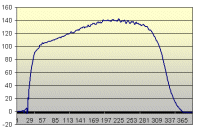 |
Jon Carter's
54mm casing burning 3 BATES grains skillet rcandy. This is the first test of this
motor. Nozzle is old-style Loki, throat is 0.435 inch diameter. New 2.3 inch long smoke grain made with rcandy/RIO burning 7 seconds per inch. Propellant weight: 536g Kn ratios: Initial, 206 Max, 242 Final, 221 Total thrust: 676Ns Burn time: 1.35 seconds, Delivered ISP: 129 Ignition was with Jon's ignitor. Bridge wire dipped in bp/nc laquer pyrogen and inserted inside a molded black powder grain about 3/8ths inch dia. It can be seen exiting the motor during ignition phase. |
Video 3 meg .wmv file 29 seconds duration |
||||||||||||||||||||||||
| 4-7-06A |
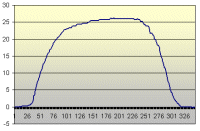
|
Jon Carter's 38mm casing
burning 2 BATES grains KN/SB propellant with 5% iron made on 5/21/05. No
apparent rust even after nearly a year in storage Delay grain 65%KNO3, 8%RIO, 27%Mr. Fiberglass epoxy. Grain length is .75 inch, drilled with 5/16this bit to .548 inch depth. Propellant weight: 112g Kn ratios: Initial, 139 Max, 175 Final, 166 Total thrust: 93Ns Burn time: 1.12 seconds, Delivered ISP: 95 Ignition was slow, but good buildup to pressure once things got going. Ejection charge fired 6.7 seconds after onset of thrust. |
Video 5 meg .mpg file 15 seconds duration |
||||||||||||||||||||||||
| 4-16-06B |
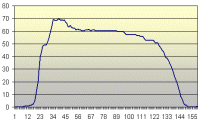
|
38-240 motor using KN/Dextrose rcandy.
Mixed 100g KNO3, 60g dextrose, and 100 ml water, prepared by the electric skillet method.
Burn rate at 1atm is 15 seconds per linear inch Propellant weight: 103.3g Kn ratios: Initial and max, 276 Final, 222 Total thrust: 128Ns Burn time: 0.53 second, Delivered ISP: 124 This test to demonstrate that KN/Dextrose can be made by the rcandy method. Apparently so, as it produced a very good propellant in this trial. No Karo was needed to achieve good working texture. |
Video 5 meg .mpg file 15 seconds duration |
||||||||||||||||||||||||
| 4-16-06E | 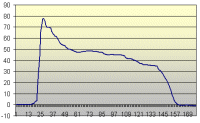 |
38-240 test of skillet rcandy using KNO3 from SVRC (pvconly.com)
acidified with 2% boric acid. Propellant turned a dark peanut
butter color and would not support its own combustion at 1 atm.
But it burned well under pressure. And it has a nice
working texture. Propellant weight: 96.6g Kn ratios: Initial and max, 272 Final, 218 Total thrust: 111Ns Burn time: 0.55 second, Delivered ISP: 118 Tall peak at beginning of burn thought due to large ignitor covered with lotsa masking tape. Seems likely that it plugged the nozzle temporarily, creating higher pressure than expected. |
Video 1 meg .wmv file 5 seconds duration |
||||||||||||||||||||||||
| 4-17-06B | 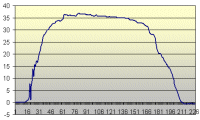 |
38-240 test of KNO3/Sorbitol skillet rcandy. Batch
4/16/06C. Tested strand on 4/16, burns very fast. Tested
again on 4/17, burns at 10 seconds per linear inch. Propellant weight: 97.2g Kn ratios: Initial and max, 272 Final, 218 Total thrust: 102Ns Burn time: 0.78 second, Delivered ISP: 107 Grain mashed a bit flat on one end, may be responsible for long taper-off in video. Good burn. |
Video 1 meg .wmv file 5 seconds duration |
||||||||||||||||||||||||
| 4-17-06C | 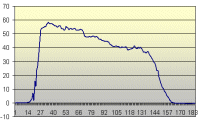 |
38-240 test of skillet rcandy using KNO3 from SVRC (pvconly.com)
acidified with 2% boric acid. Peanut butter
color, despite my stirring it every minute or so. Non-continuous
burn at 1 atm. But it still has a very nice working texture.
Propellant weight: 95.5g Kn ratios: Initial and max, 272 Final, 218 Total thrust: 108Ns Burn time: 0.58 second, Delivered ISP: 115 Except for a few jitters, thought to be test stand artifacts, this one provides a classic uninhibited-grain profile. |
Video 1 meg .wmv file 5 seconds duration |
||||||||||||||||||||||||
| 4-17-06D | 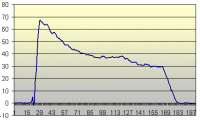 |
38-240 test of skillet rcandy using KNO3 from SVRC (pvconly.com)
acidified with 2% boric acid. Same batch as 4/17/06C Propellant weight: 96.2g Kn ratios: Initial and max, 272 Final, 218 Total thrust: 112Ns Burn time: 0.64 second, Delivered ISP: 119 Tall peak at beginning of burn thought due to tight wad of fuse paper stuffed in core of propellant grain to facilitate ignition. Apparently, it worked. |
Video 1 meg .wmv file 5 seconds duration |
||||||||||||||||||||||||
| 4-19-06B (Click for Excel Spreadsheet) |
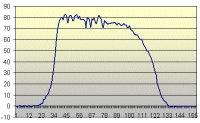 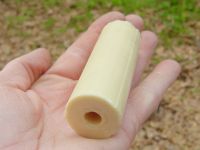 |
38-240 test of skillet rcandy using KNO3 from SVRC (pvconly.com)
acidified with vinegar which added 1.6% acetic acid. This
propellant remained light in color during the entire cooking process,
and burns at a high rate at 1 atmosphere - 6.5 seconds per linear inch.
Texture is very nice, easy to handle, easy to mold, and makes a
sturdy grain. Propellant weight: 97.6g Kn ratios: Initial and max, 272 Final, 218 Total thrust: 120Ns Burn time: 0.42 second, Delivered ISP: 125 ISP higher than 4/17 tests, thought due to faster burning propellant. Jitters on thrust curve may be test stand artifact, or maybe not, as some variation in the exhaust flame can be seen in the video. |
Video 1 meg .wmv file 5 seconds duration |
||||||||||||||||||||||||
| 4-19-06C | 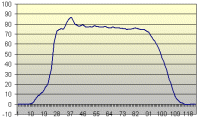 |
38-240 test of skillet rcandy using KNO3 from SVRC (pvconly.com)
acidified with vinegar which added 1.6% acetic acid. Same propellant batch as used in 4-19-06B. Propellant weight: 93.7g Kn ratios: Initial and max, 272 Final, 218 Total thrust: 112Ns Burn time: 0.39 second, Delivered ISP: 122 Another good test. This propellant burns well, if a bit fast. Texture is outstanding, leading me to wonder if the acid and heat are inverting the sugar? |
Video 1 meg .wmv file 5 seconds duration |
||||||||||||||||||||||||
| 4-23-06A | 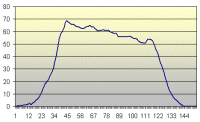 |
38-240 test of skillet rcandy using KNO3 from SVRC (pvconly.com) and Pixy Stix for sugar and acid. Texture and burn rate are good. Propellant weight: 94.2g Kn ratios: Initial and max, 272 Final, 218 Total thrust: 105Ns Burn time: 0.48 second, Delivered ISP: 114 Sucrose & citric acid had worked well before. This test is to determine if Pixy Stix has enough citric acid to neutralize this KNO3. Apparently it does. Tested on 500lbf test stand. |
Video 1 meg .wmv file 5 seconds duration |
||||||||||||||||||||||||
| 4-23-06B |  |
38-240 test of skillet rcandy using Champion Bulldog fertilizer-grade KNO3 and vinegar to acidify the mix. Texture is excellent, burn rate of 19 seconds per linear inch is good in a motor. Propellant weight: 97.2g Kn ratios: Initial and max, 272 Final, 218 Total thrust: 105Ns Burn time: 0.53 second, Delivered ISP: 110 Test to determine if acidifying this blue fertilizer KNO3 will make it work better. It's OK, but might have worked with the skillet method and no acid. I'll try that one day. Tested on 500lbf test stand. |
Video 1 meg .wmv file 5 seconds duration |
||||||||||||||||||||||||
| 4-23-06D | 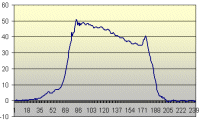 |
38-240 test of skillet rcandy using Champion Bulldog fertilizer-grade KNO3 and vinegar
to acidify the mix. This batch is very dark, a milk-chocolate
color. Texture is very good, but it does not burn continuously at
1 atmosphere. Propellant weight: 92.2g Kn ratios: Initial and max, 272 Final, 218 Total thrust: 92Ns Burn time: 0.61 second, Delivered ISP: 102 Tested on bath scale test stand. I'm not sure it is reading accurately. Low ISP could thus be a test stand artifact, the result of lower pressure, or something else. |
Video 1 meg .wmv file 5 seconds duration |
||||||||||||||||||||||||
| 4-28-06A | 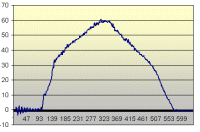 |
54mm Loki motor shortened from 3-grain length to 2 grains.
First test of this motor after its CATO at the February launch.
Jon Carter trimmed it off and cut a new groove, and also anodized
it again. Very pretty! This test is primarily to prove the modified case, and it did quite well. |
Video 5 meg .wmv file 15 seconds duration |
||||||||||||||||||||||||
| 5-6-06D | 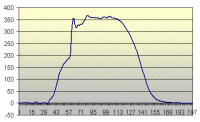 |
Loki 2000 casing,
54mm 5-grain. First test. Burning propellant made with SVRC
KNO3, Pixy Stix, Karo Syrup and vinegar. 4 BATES grains and
full-sized smoke grain. But smoke grain burned simultaneously
with propellant, yielding high thrust but no after-smoke. Propellant weight: 859g Kn ratios: Initial 273, Max, 326 Final, 301 Total thrust: 1105Ns Burn time: 0.93 second, Delivered ISP: 131 High thrust is at penalty of extreme pressure (around 1800 psi) and short burn time. Case liner is split from one end to the other. No apparent damage to motor casing. |
Video 2 meg .wmv file 7 seconds duration |
||||||||||||||||||||||||
| Spreadsheets: 5-21-06D1 No aluminum 5-21-06D2 + 5% aluminum |
Aluminum Rcandy Tests Two static tests of similar grains fired in the 38-240 casing using same nozzle throat size. One (D1) is plain rcandy with 0.5% citric acid and 0.5% red iron oxide added. The second (D2) is the same batch of propellant, but with 5% fine aluminum dust added. The aluminum is 2 micron Indian Blackhead aluminum, about a year old. The question has been posed as to whether aluminum is ignited by burning sugar propellant, and if so, what effect it might have on thrust, pressure, and other significant factors. I suspect the slow build-up to pressure of motor D2 is the primary cause of its relatively low ISP. But since the grain was not weighed (duh!) it could have been slightly lower in mass. Made in same mold as D1 grain, it should have had pretty much the same dimensions. Alternatively, adding fuel without adding more KNO3 would have made for a fuel-rich propellant, also possibly altering potential ISP. |
Photos taken at approximate peak thrust for each motor. Residue from D2 firing dropped in vial containing sodium hydroxide solution. There was a fair amount of bubbling, suggesting the presence of unburned aluminum. |
D1 Video D2 Video Each video is 1 meg .wmv file, 5 seconds Strand Burn Video 2 meg .wmv file, 10 seconds of exciting video! |
||||||||||||||||||||||||
| 5-22-06A | 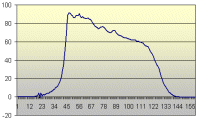 |
Aluminum Rcandy test -
replication of 5/21/06D2 but this time I remembered to weigh the grain!
Same batch of propellant used, re-heated and grain molded in same
mold. Propellant mass: 98.9g Kn ratios: Initial and max, 270 Final, 219 Total thrust: 114Ns Burn time: 0.41 second, Delivered ISP: 117 ISP is in the ballpark with previous tests using this motor, suggesting that test 5/21/06D2 was a fluke, and Al-candy propellant can offer at least normal performance. With corrected O/F ratio, it might even be an improvement. |
Video 1 meg .wmv file, 5 seconds |
||||||||||||||||||||||||
| 7-1-06A | 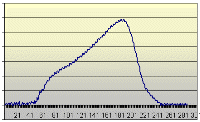 |
29mm Loki 2-grain
motor, fired with one long grain. Propellant is made from a
mixture of hard candies and food-grade KNO3. Ignitor is fuse
paper with bridge wire. Propellant mass: 45.5g Kn ratios: Initial, 129 Final and max, 222 Grain: Len 3.125, OD 0.9, Core .3125 Nozzle throat: 0.203 inches Total thrust: 56Ns Burn time: 0.74 second, Delivered ISP: 126 Quick ignition, good thrust. Curve is expected to be progressive, and it is. I'll try it with BATES grains next time. |
Video 1 meg .wmv file, 5 seconds |
||||||||||||||||||||||||
| 7-2-06D | 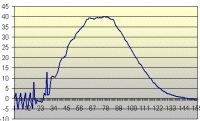 |
29mm Loki
2-grain
motor, fired with two BATES grains. Propellant is made from a
mixture of hard candies and food-grade KNO3, cooked until not
continuous at 1 atm, added 1% yellow iron oxide makes it burn 8
seconds/inch. Ignitor is fuse
paper with bridge wire. Propellant mass: 45.5g Kn ratios: Initial 166, Max 197, Final 177 Grain: Len 1.6in, OD 0.9, Core .325 Nozzle throat: 0.203 inches Total thrust: 45Ns Burn time: 0.4 second, Delivered ISP: 107 Quick ignition, good thrust. Curve is a little peakier than I expected, possibly due to the YIO. |
Video 1 meg .wmv file, 5 seconds |
||||||||||||||||||||||||
| 10-29-06B1 Spreadsheet | 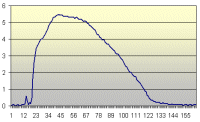 | 18mm Model rocket motor
using 3 small BATES grains. 1/4th inch nozzle made with 1/2 tsp
Bentonite, rammed in a single increment. This proves strong
enough. Kn ratios Initial: 40 Max: 44 Final: 27 Hey! I was wondering why the thurst curve was so regressive. Now I know. The grains are shorter than the ideal BATES length, and their Kn progression indicates a regressive burn.
| Video 1 meg .wmv file, 4 seconds | ||||||||||||||||||||||||
| 10-29-06B2 Spreadsheet | 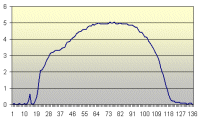 | 18mm Model Rocket motor burning a single long grain. Otherwise just like 10-29-06B1. Kn ratios Initial: 26 Final: 49
| Video 1 meg .wmv file, 5 seconds | ||||||||||||||||||||||||
| 10-29-06B3 Spreadsheet | 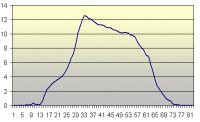 | 18mm Model Rocket motor, Single
uninhibited grain. Otherwise just like B1 and B2 above.
This is a real test of the short nozzle stack, 1 tsp Bentonite
clay rammed in a single increment. Kn ratios Initial: 40 Max: 44 Final: 27
| Video 1 meg .wmv file, 5 seconds | ||||||||||||||||||||||||
| 12-2-06B | 38-240 casing burning propellant made with Lyle's Golden Syrup and no other sugar. Kn initial and max: 272 Kn final: 188
Burn is strong, ISP in the ballpark. Flame flickers noticeably, but thrust curve follows the expected progression. Burn time is double that of regular rcandy. This may be due to extra moisture in propellant, more tests needed. | Video (1 meg .wmv file, 5 seconds of video | |||||||||||||||||||||||||
| 12-3-06B | 38-240 casing burning propellant made with Lyle's Golden Syrup and no other sugar. Replication of 12/2/06B, primarily to see if slow burn rate would recur. It did.
Burn is a little quicker than in yesterday's test, but still far slower than with my usual KN/SU propellant. | Video (1 meg .wmv file, 5 seconds of video | |||||||||||||||||||||||||
| 12-3-06C |  | 38-240 casing burning propellant made with Lyle's Golden Syrup and no other sugar. Replication of 12/2/06B
Very similar to 12-2-06B | Video (1 meg .wmv file, 5 seconds of video | ||||||||||||||||||||||||
| 12-3-06D | 38-240 casing burning propellant made with Lyle's Golden Syrup
and no other sugar. Replication of 12/2/06B, 12/3/06B&C, but
grain is molded a little larger in outside diameter, resulting in
greater grain mass, and slightly higher Kn max.
Average of the four Golden Syrup propellant burn rates is 0.2535 inches per second. Average of 4 equivalent tests with "normal" rcandy is 0.456 in/sec. (tests # 1/29/06C, 1/29/06D & 4/1/06B) Rate for 1 test burning KN/DX rcandy (4/16/06B) is 0.389 Rate for 1 test burning KN/SB rcandy (4/17/06B) is 0.261 So this "sucrose" based propellant is burning at approximately the rate of KN/sorbitol? That's weird. More tests! | Video (1 meg .wmv file, 5 seconds of video | |||||||||||||||||||||||||
| 12-10-06B | 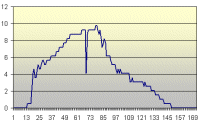 | 18mm Model Rocket motor, 4 BATES grains catalyzed rcandy.
Fired in new bath scale II test stand, using INA125 amp C. Jaggies in thrust curve are due to low resolution at this low thrust level. Deep dip near peak thrust is thought to be electromechanical artifact. Good burn, good motor. | Video (1 meg .wmv file, 6 seconds of video | ||||||||||||||||||||||||
| 12-17-06B | 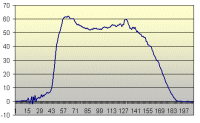 | 38-240 casing burning propellant made with Lyle's Golden Syrup
and no other sugar. Replication of 12/2/06B, 12/3/06B, C, and D except that the grain ends are inhibited. This creates a truly neutral burn profile, at least in the simulation.
In practice, we get a "saddleback" curve, reminiscent of those generated by a star grain. I averages out more neutral than the fully uninhibited grains generated in previous tests. The initial bump over 60lbf could have been due to the fuse paper pyrogen accelerating the burn briefly. The later sharp peak might have been from the waning grain breaking up, or perhaps a piece of end-inhibitor passing through the nozzle. The promise of truly-neutral burn profile is intriguing. It is an interesting challenge to get the "curve" to be truly flat. I might take that one up. | Video (1 meg .wmv file, 6 seconds of video |